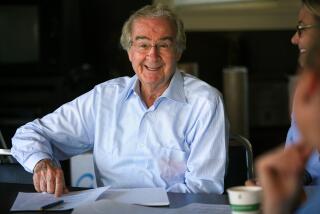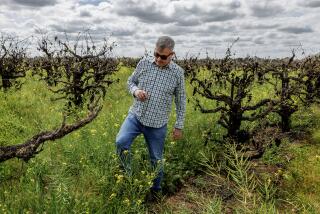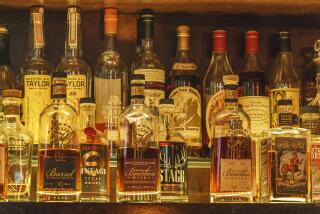Consumer Reports Toasts Beringer--Three Times
Wine supplanted the usual appliances and electronic equipment on the October cover of Consumer Reports, as the magazine’s testers applied their analytical methods to man’s second-oldest beverage.
If some of their conclusions (“There are plenty of high-quality, inexpensive wines on the market,” and, “A wine’s cost is an unreliable guide to its quality”) were unsurprising, their “best wine” selections are likely to raise eyebrows. Three of the magazine’s four top-rated wines came from California’s Beringer Vineyards.
“We’re extremely pleased that such a neutral and objective source as Consumer Reports has given our wines such great reviews,” said Phyllis Turner, public relations manager for Beringer Vineyards, based in St. Helena.
(Beringer, Napa Valley’s oldest continuously operating winery, announced in August that it planned to go public in a $100-million initial share offering.)
Among the 57 wines that Consumer Reports submitted to a blind taste test were two expensive French wines--the 1993 Lynch-Bage, a red Bordeaux, and the 1994 Puligny-Montrachet, a white Burgundy from Louis Jadot, both more than $35 a bottle.
None of the four bottles rated “best” cost more than $11.
Beringer’s 1995 Chardonnay, priced at $11, was lauded as “full-flavored, ‘oaky’ and buttery; ready to drink now, but should improve over the next two years.”
Beringer’s 1996 White Zinfandel, at $5, topped the very popular “blush wine” category. The magazine’s tasters detected “candy-banana and spicy aromas; slightly sweeter and more tart than most; the only White Zinfandel to rate ‘very good.’ ”
Among the Cabernet Sauvignons, Napa Ridge Vineyard’s Central Coast Cabernet, also a Beringer property, scored highest. Priced at just $7, is was also deemed a Consumer Reports “best buy.” The experts found it “full-flavored, with all the typical Cabernet aromas, plus plum raspberry and licorice.”
Merlot is a red grape currently enjoying great popularity. The magazine’s favorite of this variety is Chilean, produced by Walnut Crest, which was also rated one of four best wines overall.
The producer’s 1996 Rapel Valley Merlot, priced at $5, was lauded as “full-flavored and slightly fruitier” than the 11 others sampled.
The test focused on wines that sell for $15 or less, although a few expensive varieties were included as a basis for comparison.
Choices were also limited to wines that are widely available, weeding out “boutique” and other limited-production bottles. Most of the field came from California, although there were entrants from Washington, France, Australia and Italy.
In contrast to competitions conducted by most wine critics, Consumer Reports experts based their scores on the wines’ current taste and actually downgraded several wines because of high levels of tannic acid, while noting that aging would result in considerable improvement.
Among the findings:
* Price isn’t a perfect guide. “Although many inexpensive wines are mediocre and pricey ones superb, a wine’s cost is an unreliable guide to its quality,” testers concluded.
* Some wineries produce high-quality wines consistently. “In our tests, a few wineries produced wines that consistently rate high,” they said.
* Most wines are ready to drink now. “It’s a myth that all wines improve with age. Certain varietals, in fact, decline in quality as they age.”
* Vintage doesn’t always matter. The experts said the general rule on vintages is that “the higher the price of the wine, the more important the vintage. The wines we rated, by contrast, avoid peaks and valleys and aim for consistent flavor from year to year,” ostensibly by adjusting blends of grapes from a variety of sources.
More to Read
Eat your way across L.A.
Get our weekly Tasting Notes newsletter for reviews, news and more.
You may occasionally receive promotional content from the Los Angeles Times.










